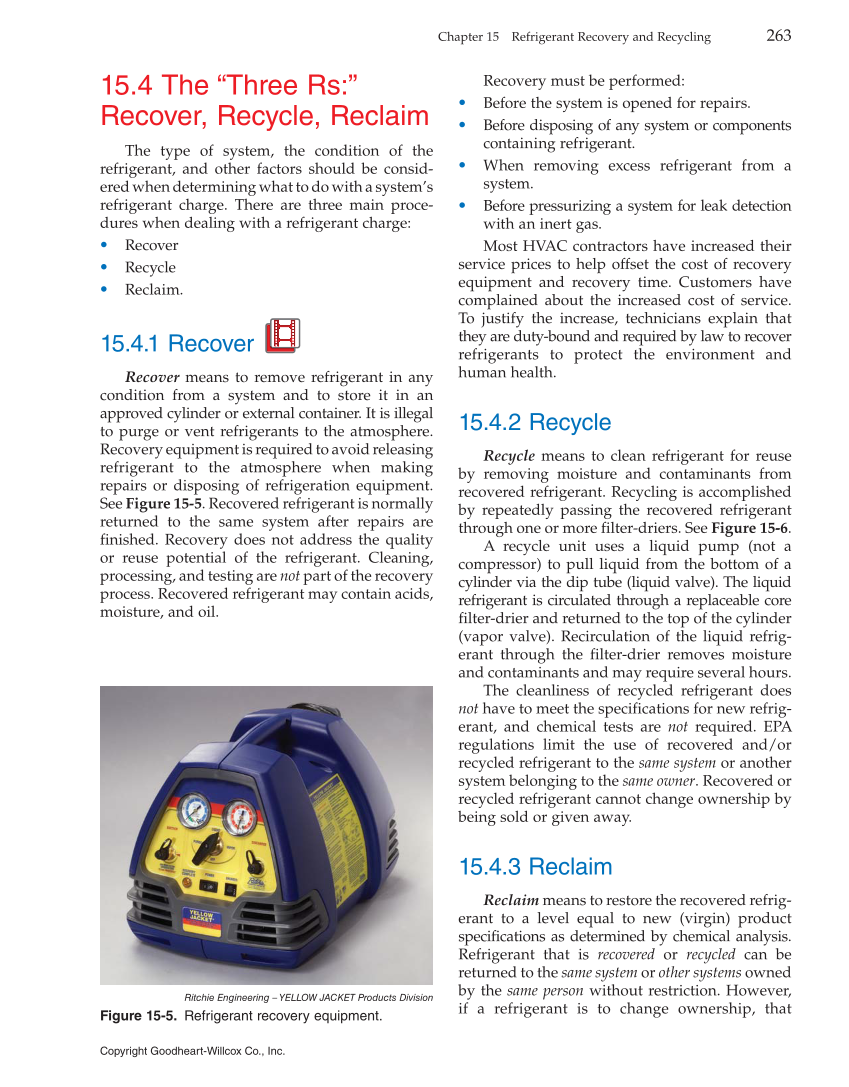Recovery must be performed: • Before the system is opened for repairs. • Before disposing of any system or components containing refrigerant. • When removing excess refrigerant from a system. • Before pressurizing a system for leak detection with an inert gas. Most HVAC contractors have increased their service prices to help offset the cost of recovery equipment and recovery time. Customers have complained about the increased cost of service. To justify the increase, technicians explain that they are duty-bound and required by law to recover refrigerants to protect the environment and human health. 15.4.2 Recycle Recycle means to clean refrigerant for reuse by removing moisture and contaminants from recovered refrigerant. Recycling is accomplished by repeatedly passing the recovered refrigerant through one or more filter-driers. See Figure 15-6. A recycle unit uses a liquid pump (not a compressor) to pull liquid from the bottom of a cylinder via the dip tube (liquid valve). The liquid refrigerant is circulated through a replaceable core filter-drier and returned to the top of the cylinder (vapor valve). Recirculation of the liquid refrig- erant through the filter-drier removes moisture and contaminants and may require several hours. The cleanliness of recycled refrigerant does not have to meet the specifications for new refrig- erant, and chemical tests are not required. EPA regulations limit the use of recovered and/or recycled refrigerant to the same system or another system belonging to the same owner. Recovered or recycled refrigerant cannot change ownership by being sold or given away. 15.4.3 Reclaim Reclaim means to restore the recovered refrig- erant to a level equal to new (virgin) product specifications as determined by chemical analysis. Refrigerant that is recovered or recycled can be returned to the same system or other systems owned by the same person without restriction. However, if a refrigerant is to change ownership, that 15.4 The “Three Rs:” Recover, Recycle, Reclaim The type of system, the condition of the refrigerant, and other factors should be consid- ered when determining what to do with a system’s refrigerant charge. There are three main proce- dures when dealing with a refrigerant charge: • Recover • Recycle • Reclaim. 15.4.1 Recover Recover means to remove refrigerant in any condition from a system and to store it in an approved cylinder or external container. It is illegal to purge or vent refrigerants to the atmosphere. Recovery equipment is required to avoid releasing refrigerant to the atmosphere when making repairs or disposing of refrigeration equipment. See Figure 15-5. Recovered refrigerant is normally returned to the same system after repairs are finished. Recovery does not address the quality or reuse potential of the refrigerant. Cleaning, processing, and testing are not part of the recovery process. Recovered refrigerant may contain acids, moisture, and oil. Ritchie Engineering – YELLOW JACKET Products Division Figure 15-5. Refrigerant recovery equipment. Chapter 15 Refrigerant Recovery and Recycling 263 Copyright Goodheart-Willcox Co., Inc.
